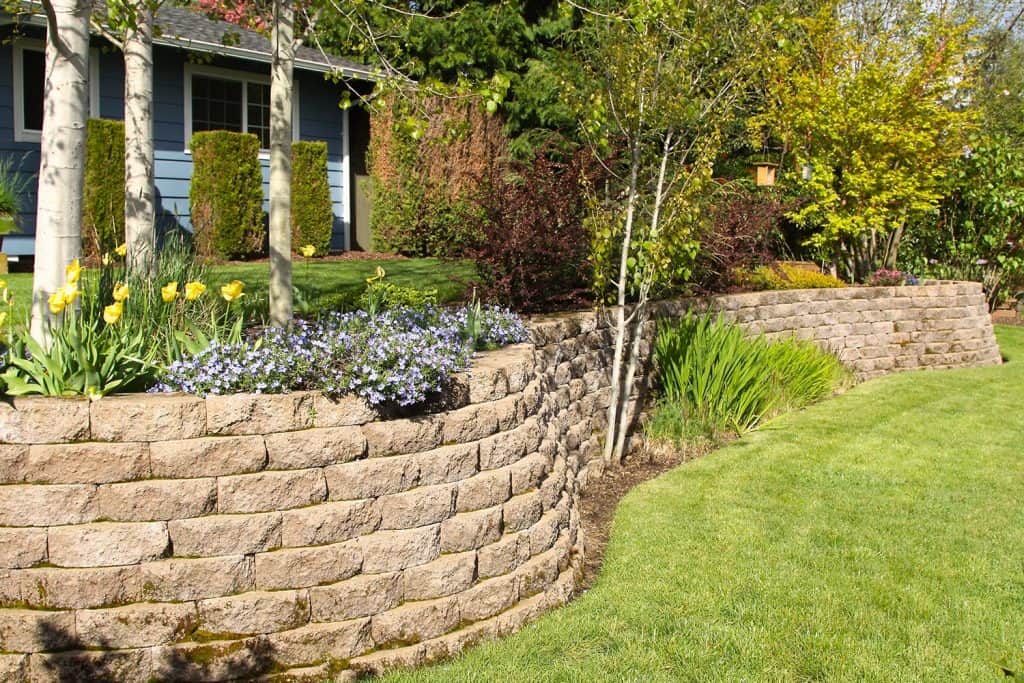Figuring out how tall a structure on your property can be isn't always easy. Do you want to build a retaining wall but don't know whether you need a permit? For your convenience, we did the research to find you some answers.
A retaining wall can reach heights of over ten feet depending on the size of your project. That said, most cities require a permit for walls over three feet tall, so remember to check your local building codes before breaking ground.
As we begin, we will cover all things retaining walls and whether you need a permit to build one. Regardless of where you live, it is essential to build a retaining wall tall enough to prevent runoff and flooding while also staying within your cities regulations. With that said, let's jump right into this post!
![Fragment of a retaining wall made of gabions, How Tall Can A Retaining Wall Be? [Inc. Without A Permit]](https://gardentabs.com/wp-content/uploads/2021/09/How-Tall-Can-A-Retaining-Wall-Be.-683x1024.png)
How Tall Should A Retaining Wall Be?
Generally, you shouldn't need to build your retaining wall taller than three to four feet. Especially for those in certain cities or geographical locations, building higher than four feet requires city permission and expensive engineering.

Another thing to consider is what you need a retaining wall for, whether flooding, erosion, or both during severe weather.
How Tall Can A Retaining Wall Be Without A Permit?
Like we mentioned, most cities will require you to apply for a permit if your retaining wall is taller than three to four feet. Of course, these regulations vary depending on where you live and what type of land your wall is being built on.
For example, if you live in Phoenix, Arizona and want to build a retaining wall, you need to apply for a permit for anything taller than three feet.
What Is The Minumum Width Of A Retaining Wall?
According to engineer Brian Walker of Wallace Design, a retaining wall should be 1/2 to 1/3 the height of your structure. This is because if your wall is too tall for its base to handle, you risk your structure collapsing during bad weather.
So, for example, if you want to build a three-foot-tall retaining wall, you will need to make it at least 12 inches wide.
How Deep Should A Base Be For A Retaining Wall?
When it comes to the base of your wall, try to keep it around four to six inches deep. Whether you use concrete, stone, or brick, make sure to bury half of your wall's first layer into the ground.
Doing this will secure your retaining wall and prevent it from sliding or toppling over during a storm.
How Tall Can A Wood Retaining Wall Be?

For anyone building a wood retaining wall, try to keep it around four feet in height. Like we covered earlier, most cities have a height limit on non-permitted structures of three to four feet, including retaining walls.
Another reason to keep your wood retaining wall under four feet is that anything taller will need extra support, which can be expensive. Of course, if your property requires a taller wall, you can always reach out to your city about what codes you need to follow.
Are Wood Retaining Walls Sturdy?
When it comes to the sturdiness of a wooden retaining wall, we think they are a pretty hardy option. As long as you build your wall well, it should last you decades to come and require very little maintenance.
Material-wise, try to use a strong wood like Douglas Fir for your structure so you won't have to worry about it during severe conditions. Regardless, the thicker the wood you use, the better your wall will hold out in the long run.
How Close To A Fence Can You Build A Retaining Wall?
For anyone wanting to build a retaining wall near an existing fence, try to keep it at least three feet away. According to the International Building Code, non-engineered retaining walls must be three feet away from existing fencing.
The reason for this is because fencing can create a surcharge, meaning during a storm, it can amplify winds and destroy your retaining wall. Of course, every location has different conditions, so we recommend contacting an engineer or contractor to assess the area.
How Close To A Property Line Can You Build A Retaining Wall?
Although city codes vary, most times, you can build your retaining wall within a foot of your property line. That said, if an exact line isn't yet established, you will need to get permission from your neighbors or the city if it is on their property.
For example, if you decide to build a retaining wall in Andover, Minnesota, you are legally allowed to have it immediately adjacent to your private property line.
Can I Build A Retaining Wall Next To My House?

If your home is near a steep slope or in a flood zone, you can certainly build a retaining wall near it. With that said, your wall will need drainage, so it is better not to build too close to your house.
Generally, it is best to give your home a few feet of space between it and a retaining wall to prevent structural damage if there is flooding or runoff.
How Close To A Structure Can I Build A Retaining Wall?
Distance-wise, we found that a retaining wall should be at least two to three feet away from any structures. Giving your wall this space allows for drainage and an area of failure if your wall becomes damaged during a storm.
With that said, we recommend installing landscape fabric behind your retaining wall to prevent flooding and keep your home as safe and dry as possible.
Super Geotextile - 6 oz Geotextile
This semi-permeable landscape fabric is durable, easy to install, and comes in various sizes.
Follow this link to see it on Amazon.
How Do I Choose A Retaining Wall?
When it comes to choosing a retaining wall, consider what size and function it needs to have. Typically, retaining walls help prevent soil erosion, runoff, and flooding while keeping your home and property safe.
Having a sturdy, well-built retaining wall can make a world of difference, especially for those living at the bottom of a steep hill or slope.
Of course, if you aren't sure about where to build your structure or what permits you need, it never hurts to reach out to a professional to discuss your options.
What Is The Best Material For Building A Retaining Wall?
Material-wise, poured concrete, brick, and stone are all good options for a retaining wall. Of the three, poured concrete will give your wall the most design options and is one of the sturdier choices.
Regardless, we recommend lining your retaining wall with landscaping fabric and adding gravel or stone behind it to help drain water and protect your wall.
AA Plus Shop 50 Pound Premium Mexican Beach Stones
This bag of 50-pound stones comes from the beaches of Baja Mexico, helps with soil erosion, and are between three and five inches.
Click this link to see them on Amazon.
How Much Does It Cost To Build A Retaining Wall?

Typically, you can expect to spend between $3,000 and $8,000 on a retaining wall. Depending on how tall you want your wall and what materials you use, this will determine its final price tag.
A standard cinder block wall should cost you between $10 and $12 per square foot, while poured concrete costs nearly double.
That said, labor is usually an added $25 per square foot on top of materials, so you might want to consider inviting some friends over to help instead.
Does It Cost Money To Get A Building Permit?
For those needing a permit for their retaining wall, this usually only costs about $20-$60. Depending on where you live, building permit prices will vary, but you shouldn't have to spend more than $100 to get your retaining wall approved.
That said, if your structure is under the permit-required height, you do not have to pay any fees to the city before breaking ground.
To Wrap It Up
Whether you want to build a retaining wall or have just started researching, it is essential to check your local building codes before getting started. Retaining walls under four feet won't usually require a permit, but this does vary depending on where you live.
Ten feet is usually the max for how tall a retaining wall can be, although we recommend staying under that. For width, make sure the base of your retaining wall measures at least one-third of its overall height.
Regardless, always check your cities permit requirements, and don't be afraid to schedule a consultation with a contractor or engineer before getting started.
Before you go, be sure to check out these helpful garden posts below!
How Long Do Retaining Walls Last? [Inc. Wood Ones]
Can You Build A Retaining Wall On Concrete? [Plus How-To Tips]
Should You Add A Fence To A Retaining Wall? [And How To Do So]


